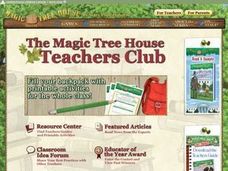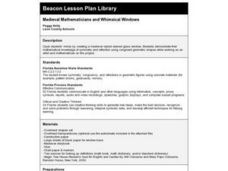Curated OER
Magic Tree House - Afternoon on the Amazon chapter 6
In this comprehension worksheet, students read the book Afternoon on the Amazon chapter 6 from Magic Tree House, and answer short answer questions and define vocabulary words. Students complete 9 problems.
Curated OER
Magic Tree House: Midnight on the Moon
Take your class to the moon with Midnight on the Moon! Then provide them with this short packet to develop vocabulary and practice reading comprehension. The first page has readers match vocabulary terms to their correct definitions. The...
Curated OER
Enchanting Egypt
After reading the Magic Tree House book Mummies in the Morning, learners talk about Ancient Egypt. They identify the plot, characters, setting, etc., explore vocabulary terms, and construct a pyramid. This will motivate your class to...
Curated OER
Mystery Dinosaur: Who am I?
In this dinosaur worksheet, students read a description of a dinosaur and then write down which dinosaur is being described. There are 6 questions to answer on this worksheet.
Curated OER
Library Lingo Crossword
In this library lingo crossword puzzle worksheet, students use the 6 clues to determine the 6 literary genre names that complete the word puzzle.
Curated OER
Hurricane
Students use children's literature in order to investigate the concept of hurricanes and how they occur. The metaphor is used to describe a play area that is magical. They use their imaginations and write about their favorite places to...
Curated OER
Lions at Lunchtime
In this literature study unit, 4th graders read the book Lions at Lunchtime and match ten vocabulary words to the definitions and seven short answer questions based on chapters 1 and 2. Students read chapters 3,4, and 5 and answer twelve...
Curated OER
Descendants on Ice
In this animal worksheet, students use a Venn diagram to compare and contrast a prehistoric creature with an animal living today.
Curated OER
Medieval Mathematicians and Whimsical Windows
Third graders demonstrate their mathematical knowledge of symmetry and reflection using congruent geometric shapes while working as an artist and mathematician looking at a medieval-styled stained glass window.
Curated OER
Civil War on Sunday
Third graders read "Cvil War on Sunday" together and discuss characters, setting, problem and resolution. They determine facts from fiction used in the story and research drummer boys in the Civil War or Clara Barton using the Internet....
Curated OER
Comparing The Earth And Moon
Third graders engage in a lesson plan that compares the Sun and Moon. They conduct research using the websites included in the lesson plan. Students read literature in order to make a connection with the new information. The plan...
August House
The Great Smelly, Slobbery, Small-Tooth Dog
Read the story The Great Smelly, Slobbery, Small-Tooth Dog: A Folktale from Great Britain by Margaret Read MacDonald and choose from multiple activities to learn about the tale's theme—kindness. With so many options, your kind kids will...
Curated OER
Introducing the Super 3 Research Model
Fourth graders read the fiction selection, Dolphins at Daybreak, and then the corresponding non-fiction books about dolphins and sharks. They use a specific research model to find information about dolphins and sharks from books and...
Curated OER
An Emerald Place
Students discover four layers of the rain forest and identify the life of animals at each level.
Curated OER
Nouns
In this nouns worksheet, students review the definition for common and proper nouns. Students then circle the common nouns in the sentences. Students write the common nouns to complete each sentence.
















